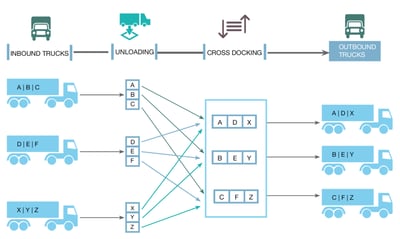Nowadays everyone tries to find the most efficient ways to speed up their days and save themselves some money. Makes sense, right? In the logistics world, nothing is more important than being efficient and quick.
One way businesses can be more productive is through cross-docking. Cross-docking is an important middle process of the supply chain, which freight movement shipped by a supplier is distributed directly onto outbound trucks with minimal or no warehousing space used in between. Advancements in technology have made this possible by enabling real-time information exchange and analysis.
This process begins once an inbound transportation (LTLs, FTLs, railroad car, etc.) docks to the distribution center, then the products are unloaded to the terminal, screened and sorted, reloaded to the outbound dock and placed on the correct truck going to that products destination. The time these products spend at the distribution center average about 24 hours but sometimes can be less than an hour!

3 Advantages of adding cross-docking into your logistics plan:
Reduces Costs: The categories in which a company will be able to see money being saved is warehousing, handling, packaging, transportation, and distribution costs. The more time your products sit at a distribution center the more money you spend. Cross-docking saves you more than time but also slashes your expenses. One of the costliest expenses for most retailers is the warehousing space, but with cross-docking you have the ability to eliminate this cost. Additionally, since the products that are destined for a similar end point will now be transported together, transportation costs will be driven down. Lastly, unnecessary processes such as “pick-location” would also be eliminated saving you money on fuel and mileage.
Saving Time/Increasing Efficiency: The traditional warehousing structure involves a distributor who keeps inventory on hand then ships the products out to customers at the appropriate time. With cross-docking, the time it takes to ship freight decreases because it focuses on the just-in-time (JIT) shipping process. Cross-docking also increases a supply chain’s overall efficiency by enabling shippers to ship full truckloads to a single cross dock for distribution and minimizes touch points between pick up and final delivery. For example, if a retailer in New York must send products to California it would be more efficient to send one full truck load than multiple LTLs.
Minimize Inventory handling risk: Since cross-docking lessens or can even eliminate the product being in the warehouse, it also reduces the amount of times the product is handled. The minimal handling cross-docking allows significantly reduces the probability of damage to inventory. This can help businesses save money and help reduce issues with distribution centers.




